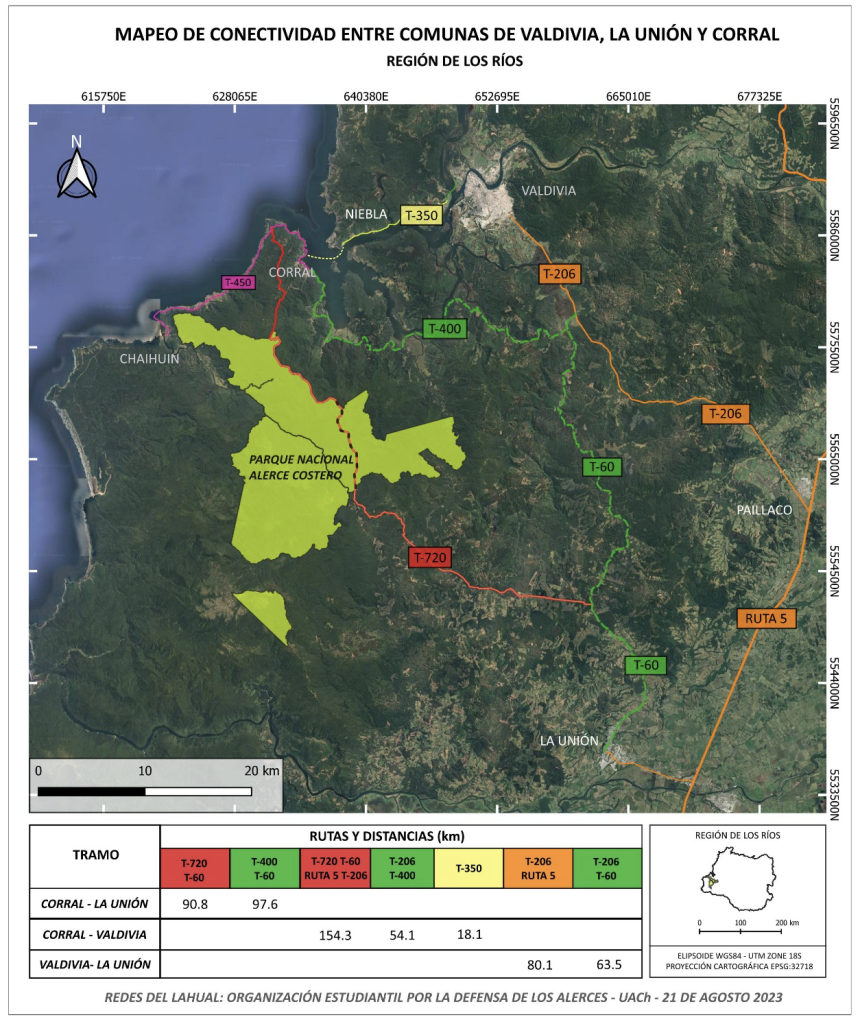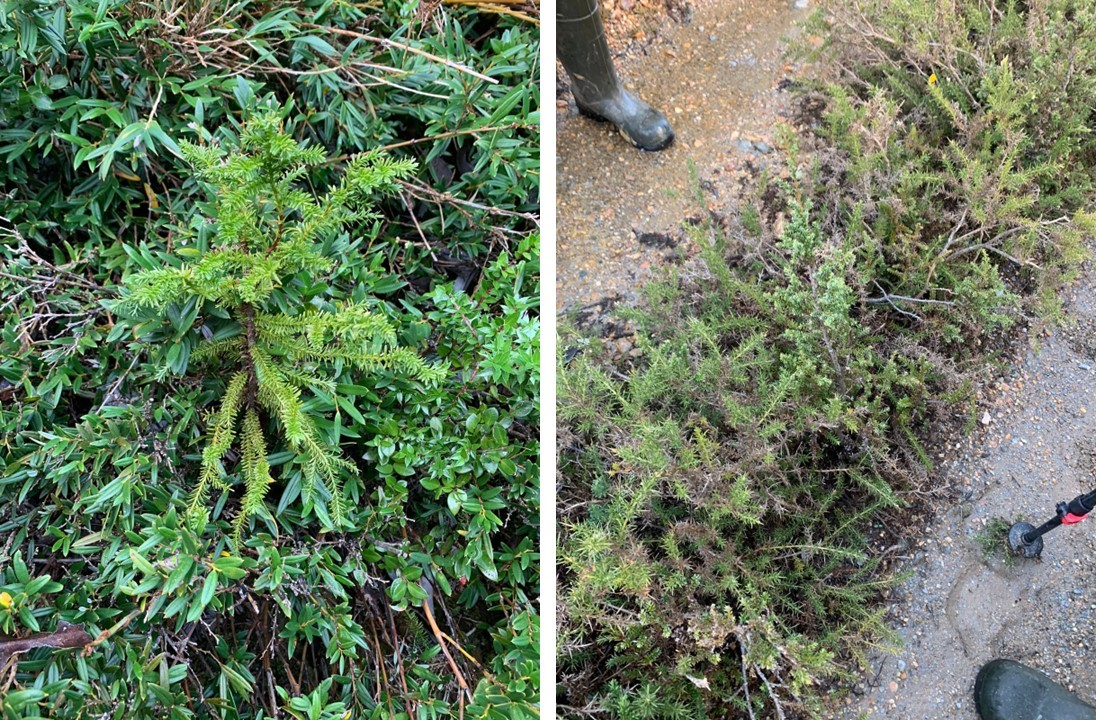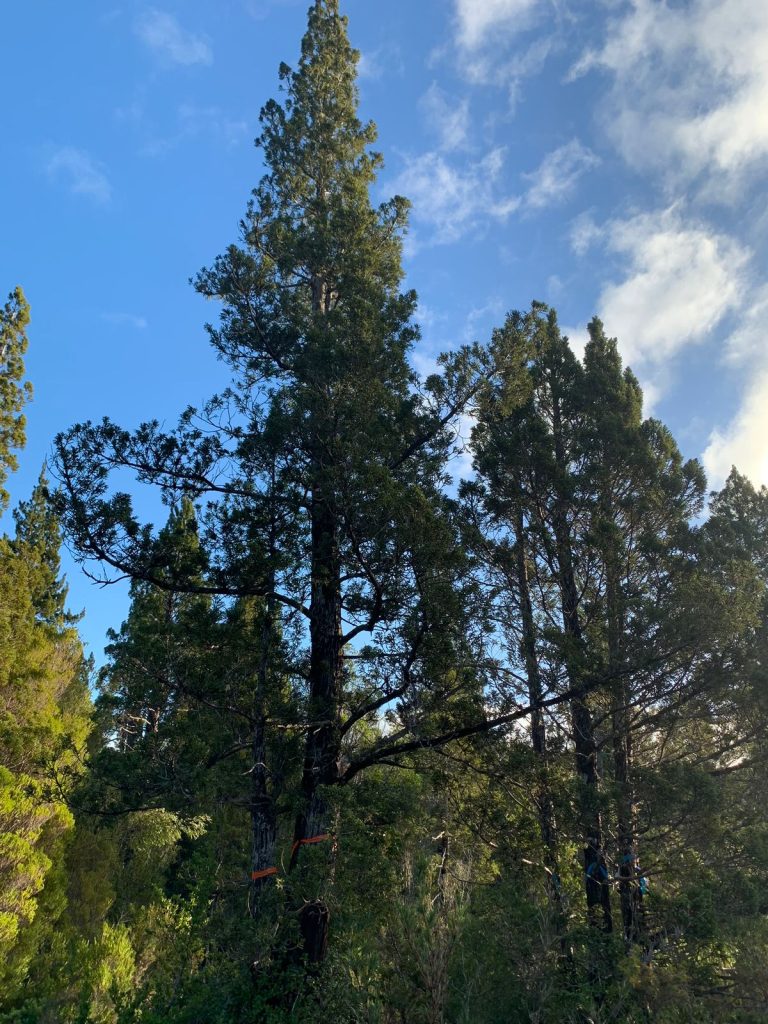By Rocío Urrutia, academic at the University of Aysén and researcher at CR2, and Alejandro Miranda, researcher at the Department of Forestry Sciences at the University of La Frontera and CR2.
- The State has decided to restore the route that four decades ago crossed what is now a National Park located in the Los Ríos Region, which would mean cutting down hundreds of endangered Alerce trees.
- This decision will irreversibly affect the flora and fauna with conservation issues in the area, such as the Chiloé fox, the güiña, and the Guaitecas cypress.
- Studies indicate that forest fires are more likely to occur near roads and will intensify in the future, so if this road is built, the park will be heavily threatened by fire.
Supreme Decree No. 9 of the Ministry of National Assets created the Alerce Costero National Park, a protected area located in the communes of Corral and La Unión in the Los Ríos Region. According to this 2010 Decree, the park was created to officially protect the temperate rainforest ecoregion, which, given its global conservation priority and high risk of biodiversity loss, needed to be safeguarded under the National System of Protected Areas of the State. It also reinforces that, according to the National Biodiversity Strategy, the Coastal Range of the Los Ríos Region is one of the priority areas to protect due to its high conservation value. Additionally, this National Park is the only State area that preserves the northernmost population of Alerces (Fitzroya cupressoides) in Chile, also protecting the oldest tree in the southern hemisphere.
The Alerce Costero Park Management Plan indicates that this area is a refuge for various endemic species, many of them classified due to their conservation status, such as the “Valdivia gayana” plant classified as rare and vulnerable; and others in danger like the “Alsodes valdiviensis” frog, the Chiloé fox (Lycalopex fulvipes), and the Alerce itself. In the park, and in many cases growing alongside the Alerce, also lives the Guaitecas cypress (Pilgerodendron uviferum), a species categorized as “vulnerable” by the International Union for Conservation of Nature (IUCN) but not yet categorized as such by Chile despite its scarce and restricted distribution in the Los Ríos Region.

Despite all this, an environmental impact study has been presented for the construction of part of Route T-720, a road that historically connected the communes of La Unión and Corral when the area did not yet have the National Park. Specifically, the construction of the section that crosses this park is desired (Figure 1), and according to the executive summary of the study, the length of this section is approximately ten kilometers.

The study indicates that this road stopped being used in the 1980s due to the collapse of the La Piedra bridge, which caused it to lose connectivity. Due to this disuse, the vegetation of the area recovered ground, and currently, Alerces and other species are regenerating on the edges and in the center of this highly rocky track (Figure 2).
The main objective of reconstructing this section of Route T-720 is to reconnect the communes of La Unión and Corral, contributing to the social, productive, and tourist development of the area. However, this work would generate irremediable environmental impacts, including:
Habitat fragmentation as the route crosses part of the National Park Direct impact on the regeneration of Alerce and Guaitecas cypress growing on the old road and its edges Arrival of feral dogs and other invasive species that threaten native fauna and overall biodiversity Loss of native vegetation due to material runoff during the road’s construction and use Increased risk of forest fires, which due to the high fuel load, could be of high energy release, threatening biodiversity and the surrounding population.
Additionally, for the recovery of this route, large centuries-old Alerces along the track will be cut down, which are irreplaceable (Figure 3). Increased vehicle presence due to future road recovery would also encourage illegal logging and the running over of native fauna.

Thus, it is considered that the construction of Route T-720 could irremediably affect the Alerce Costero National Park and the species that inhabit it, given that there are other alternatives to connect the communes of Corral and La Unión that would not generate this significant impact on an ecosystem decided to be protected under the highest conservation standard in Chile. The societal consensus to protect this ecosystem by categorizing it as a National Park due to its extremely high conservation value should not be altered by decisions outside the national interest of conserving its natural heritage in the long term. It is the State’s duty to ensure its preservation, avoiding adding threats to its conservation objects.
In a recent letter, Environment Minister Maisa Rojas, in the context of the Intergovernmental Science-Policy Platform on Biodiversity and Ecosystem Services (IPBES) report on invasive species, stated that “as a planet and as a country we are facing a triple environmental crisis: pollution, climate change, and biodiversity loss.” As the minister points out, Chile has adopted international commitments at the COP15 on biodiversity where countries aim to “eliminate, minimize, reduce or mitigate the impacts of invasive alien species by 2030.” On the other hand, the director of the National Forestry Corporation (CONAF) Christian Little, in the context of the repeal of DL 701, has stated that “regarding native forests, management and restoration must be to produce wood and also to maintain or recover key ecosystem services for biodiversity conservation, ecological balance, and long-term social well-being.” In both cases, there is an expressed willingness of the State to avoid biodiversity loss both by the authorities’ own conviction and by the commitments the country has made in a context of multiple environmental challenges.
Protected areas, particularly those housing endangered species, play a central role in these long-term national goals. However, the proposal to build this road clearly contravenes these objectives. The State must confirm its conviction to protect biodiversity in the long term, seeking alternatives that allow territorial development without compromising its most precious and vulnerable natural treasures, as the opposite logic has led us to the triple environmental crisis.
Recommendations
- Considering that Corral currently has connectivity problems, it is recommended to pave Route T-400, which connects this commune with Valdivia, the capital of the Los Ríos Region (Figure 1), as this road covers a distance of only 54 kilometers, while the total distance between Corral and La Unión via Route T-720 is 90.8 kilometers.
- At the same time, it is recommended to improve Route T-60, which connects Valdivia with La Unión.
- The sum of Routes T-60 and T-400 implies only a seven-kilometer increase in the distance between La Unión and Corral compared to Route T-720 and would generate three positive impacts: a. Better connectivity through a paved road between both communes and between them and the regional capital; b. Local tourism would be boosted as it borders the Futa River and also the transport of supplies; c. The impact on high-priority conservation ecosystems currently protected by the Alerce Costero National Park would be avoided.
References
- National Forestry Corporation. (2014). Alerce Costero National Park Management Plan Operational Document. Ministry of Agriculture. https://www.conaf.cl/wp-content/files_mf/1445455916PM_PNAlerceCostero.pdf
- Road Directorate. (2019). Environmental impact study “Intermediate Section Route T-720 Crossing T-60 (Las Ventanas) – Alerce Costero – Crossing T-450 (Corral) Province of Valdivia.” Executive Summary. Ministry of Public Works.
- González, M.E., Sapiains, R., Gómez-González, S., Garreaud, R., Miranda, A., Galleguillos, M., Jacques, M., Pauchard, A., Hoyos, J., Cordero, L., Vásquez, F., Lara, A., Aldunce, P., Delgado, V., Arriagada Ugarte, A.M., Sepúlveda, A., Farías, L., García, R., Rondanelli, R.J., Ponce, R., Vargas, F., Rojas, M., Boisier, J.P., Carrasco, C., Little, C., Osses, M., Zamorano, C., Díaz-Hormazábal, I., Ceballos, A., Guerra, E., Moncada, M., Castillo, I. (2020). Forest Fires in Chile: Causes, Impacts, and Resilience. Center for Climate and Resilience Science (CR2) (ANID/FONDAP/15110009), 84 pp. Available at https://www.cr2.cl/incendios/
- Little, C. (September 22, 2023). From Decree Law 701 to Multifunctional Territories. El Mostrador. https://www.elmostrador.cl/noticias/opinion/columnas/2023/09/22/del-decreto-ley-701-a-territorios-multifuncionales/?s=08
- Ministry of National Assets. (2019). Decree 9 Defects from its quality of such lands that it indicates and creates the Alerce Costero National Park located in the communes of Corral and La Unión, provinces of Valdivia and Ranco, Los Ríos Region. https://www.bcn.cl/leychile/navegar?idNorma=1019146
- Ministry of the Environment. (2022). List of Classified Species from the 1st to the 17th Classification Process RCE (updated to May 2022).
- Rojas, M. (September 23, 2023). Dangers and Costs of Bioinvasion: The Chilean Case. El Mostrador. https://www.elmostrador.cl/noticias/opinion/columnas/2023/09/23/peligros-y-costos-de-la-bioinvasion-el-caso-chileno/
- Urrutia-Jalabert, R., Barichivich, J., Gutiérrez, Á.G., & Miranda, A. (2023). Chile’s road plans threaten ancient forests. Science, 380(6648), 903-903. https://www.science.org/doi/10.1126/science.adi0228



